Consider a combined gassteam power plant shown below The top
Consider a combined gas–steam power plant shown below. The “top cycle” generates 600 MW of power.
Air enters the compressor at 310 K, the combustion chamber at 700 K and the turbine at 1500 K. The combustion gases enter the heat exchanger at 850 K and exit at 520 K. The combustion gases exiting the gas turbine are used to heat the steam (State 3) to 12.5 MPa to 500o C in a heat exchanger. Steam expands in a high-pressure turbine to a pressure of 2.5 MPa and is reheated in the heat exchanger to 500o C before it expands in a low-pressure turbine to 10 kPa. Assume all heat exchangers operate at constant pressure and isentropic efficiencies of 0.90 percent for the pump, and 0.83 percent for steam turbines.
(a) the mass flow rate of air in the gas-turbine cycle, [kg/s]
(b) the rate of total heat input into the combustion chamber [MW]
(c) the thermal efficiency of the combined cycle [%]
Combustion chamber Compressor Heat 11 exchanger pump Gas turbine 10 Steam turbine CondenserSolution
Effect of Gas/Steam Turbine Inlet Temperatures on Combined Cycle Having Air Transpiration Cooled Gas Turbine
Science.gov (United States)
Kumar, S.; Singh, O.
2012-10-01
Worldwide efforts are being made for further improving the gas/steam combined cycle performance by having better blade cooling technology in topping cycle and enhanced heat recovery in bottoming cycle. The scope of improvement is possible through turbines having higher turbine inlet temperatures (TITs) of both gas turbine and steam turbine. Literature review shows that a combined cycle with transpiration cooled gas turbine has not been analyzed with varying gas/steam TITs. In view of above the present study has been undertaken for thermodynamic study of gas/steam combined cycle with respect to variation in TIT in both topping and bottoming cycles, for air transpiration cooled gas turbine. The performance of combined cycle with dual pressure heat recovery steam generator has been evaluated for different cycle pressure ratios (CPRs) varying from 11 to 23 and the selection diagrams presented for TIT varying from 1,600 to 1,900 K. Both the cycle efficiency and specific work increase with TIT for each pressure ratio. For each TIT there exists an optimum pressure ratio for cycle efficiency and specific work. For the CPR of 23 the best cycle performance is seen at a TIT of 1,900 K for maximum steam temperature of 570 °C, which gives the cycle efficiency of 60.9 % with net specific work of 909 kJ/kg.
Gas Turbine Engine Inlet Wall Design
Science.gov (United States)
Florea, Razvan Virgil (Inventor); Matalanis, Claude G. (Inventor); Stucky, Mark B. (Inventor)
2016-01-01
A gas turbine engine has an inlet duct formed to have a shape with a first ellipse in one half and a second ellipse in a second half. The second half has an upstream most end which is smaller than the first ellipse. The inlet duct has a surface defining the second ellipse which curves away from the first ellipse, such that the second ellipse is larger at an intermediate location. The second ellipse is even larger at a downstream end of the inlet duct leading into a fan.
Impact of inlet air cooling on gas turbine performance
OpenAIRE
Szymon Jarzębowski; Ewa Pyzik; Andrzej Miller
2012-01-01
In this article different possibilities of gas turbine inlet air cooling were presented. The method of defining power gain caused by air cooling was discussed. The results of increasing power output level of several different turbines and one gas turbine in combine cycle in domestic ambient conditions were presented and discussed. Significant turbine power gains were received.
Thermodynamic assessment of impact of inlet air cooling techniques on gas turbine and combined cycle performance
International Nuclear Information System (INIS)
The article is focused on the comparison of impact of two different methods of inlet air cooling (vapor compression and vapor absorption cooling) integrated to a cooled gas turbine based combined cycle plant. Air-film cooling has been adopted as the cooling technique for gas turbine blades. A parametric study of the effect of compressor pressure ratio, compressor inlet temperature (Ti,C), turbine inlet temperature (Ti,T), ambient relative humidity and ambient temperature on performance parameters of plant has been carried out. Optimum Ti,T corresponding to maximum plant efficiency of combined cycle increases by 100 °C due to the integration of inlet air cooling. It has been observed that vapor compression cooling improves the efficiency of gas turbine cycle by 4.88% and work output by 14.77%. In case of vapor absorption cooling an improvement of 17.2% in gas cycle work output and 9.47% in gas cycle efficiency has been observed. For combined cycle configuration, however, vapor compression cooling should be preferred over absorption cooling in terms of higher plant performance. The optimum value of compressor inlet temperature has been observed to be 20 °C for the chosen set of conditions for both the inlet air cooling schemes. - Highlights: • Inlet air cooling improves performance of cooled gas turbine based combined cycle. • Vapor compression inlet air cooling is superior to vapor absorption inlet cooling. • For every turbine inlet temperature, there exists an optimum pressure ratio. • The optimum compressor inlettemperature is found to be 293 K
An Alternative Ice Protection System for Turbine Engine Inlets Project
Data.gov (United States)
National Aeronautics and Space Administration — This proposal presents a dual approach to the development and certification of an alternative system for ice protection of turbine engine inlets. It combines a new...
Application of LES in the study of inlet flow field in marine gas turbine
Institute of Scientific and Technical Information of China (English)
SHI Bao-long; SUN Hai-ou; SUN Tao; HU Yan-yong
2005-01-01
The structure and aerodynamics performance of gas turbine inlet system is an important part of technology of gas turbine installed on naval vessels. The design and numerical simulations of gas turbine inlet system are conducted and reliable foundation for design and manufacture of marine gas turbine inlet system of high performance is provided. Numerical simulations and experiments of two inlet system models of gas turbine are conducted with satisfactory results and are of significance to the actual application of the inlet system.
Development of Steam Turbine Inlet Control Valve for Supercritical Pressure at Siemens Industrial Turbomachinery AB
OpenAIRE
Sors, Felix; Holm, Patrik
2010-01-01
The development in the steam turbine business is heading for applications with much higher steam parameters since this enables a raised efficiency. Steam parameters refer to the pressure and the temperature of the steam. The aim of this study was to generate concepts for steam turbine inlet control valves designed for higher pressure and temperature in comparison with the present design. Future steam power plants using solar energy, based on tower technology, request this kind of performance ...
Inlet Turbulence and Length Scale Measurements in a Large Scale Transonic Turbine Cascade
Science.gov (United States)
Thurman, Douglas; Flegel, Ashlie; Giel, Paul
2014-01-01
Constant temperature hotwire anemometry data were acquired to determine the inlet turbulence conditions of a transonic turbine blade linear cascade. Flow conditions and angles were investigated that corresponded to the take-off and cruise conditions of the Variable Speed Power Turbine (VSPT) project and to an Energy Efficient Engine (EEE) scaled rotor blade tip section. Mean and turbulent flowfield measurements including intensity, length scale, turbulence decay, and power spectra were determined for high and low turbulence intensity flows at various Reynolds numbers and spanwise locations. The experimental data will be useful for establishing the inlet boundary conditions needed to validate turbulence models in CFD codes.
Impact of the use of a hybrid turbine inlet air cooling system in arid climates
International Nuclear Information System (INIS)
Graphical abstract: Cooling the air entering the compressor section of a gas turbine is a proven method of increasing turbine power output, especially during peak summer demand, and it is increasingly being used in powerplants worldwide. Two turbine inlet air cooling (TIAC) systems are widely used: evaporative cooling and mechanical chilling. In this work, the prospects of using a hybrid turbine inlet air cooling (TIAC) system are investigated. The hybrid system consists of mechanical chilling followed by evaporative cooling. Such a system is capable of achieving a significant reduction in inlet air temperature that satisfies desired power output levels, while consuming less power than conventional mechanical chilling and less water than conventional evaporative cooling, thus combining the benefits of both approaches. Two hybrid system configurations are studied. In the first configuration, the first stage of the system uses water-cooled chillers that are coupled with dry coolers such that the condenser cooling water remains in a closed loop. In the second configuration, the first stage of the system uses water-cooled chillers but with conventional cooling towers. An assessment of the performance and economics of those two configurations is made by comparing them to conventional mechanical chilling and using realistic data. It was found that the TIAC systems are capable of boosting the power output of the gas turbine by 10% or more (of the power output of the ISO conditions). The cost operation analysis shows clearly the hybrid TIAC method with wet cooling has the advantage over the other methods and It would be profitable to install it in the new gas turbine power plants. The figure below shows a comparison of the water consumption for the three different cases. - Highlights: • New hybrid system for the turbine inlet air cooling is studied. • Hybrid system of mechanical chilling followed by evaporative cooling is used. • Hybrid turbine inlet air cooling
Comparison of evaporative inlet air cooling systems to enhance the gas turbine generated power
Energy Technology Data Exchange (ETDEWEB)
Mohammad Ameri; Shahbazian, H.R.; Nabizadeh, M. [Power and Water University of Technology, Tehran (Iran). Energy Engineering Dept.
2007-12-15
The gas turbine performance is highly sensitive to the compressor inlet temperature. The output of gas turbine falls to a value that is less than the rated output under high temperature conditions. In fact increase in inlet air temperature by 1{sup o}C will decrease the output power by 0.7% approximately. The solution of this problem is very important because the peak demand season also happens in the summer. One of the convenient methods of inlet air cooling is evaporating cooling which is appropriate for warm and dry weather. As most of the gas turbines in Iran are installed in such ambient conditions regions, therefore this method can be used to enhance the performance of the gas turbines. In this paper, an overview of technical and economic comparison of media system and fog system is given. The performance test results show that the mean output power of Frame-9 gas turbines is increased by 11 MW (14.5%) by the application of media cooling system in Fars power plant and 8.1 MW (8.9%) and 9.5 MW (11%) by the application of fog cooling system in Ghom and Shahid Rajaie power plants, respectively. The total enhanced power generation in the summer of 2004 was 2970, 1701 and 1340 MWh for the Fars, Ghom and Shahid Rajaie power plants, respectively. The economical studies show that the payback periods are estimated to be around 2 and 3 years for fog and media systems, respectively. This study has shown that both methods are suitable for the dry and hot areas for gas turbine power augmentation. (author)
Comparative Exergoeconomic Analyses of Gas Turbine Steam Injection Cycles with and without Fogging Inlet Cooling
Directory of Open Access Journals (Sweden)
Hassan Athari
2015-09-01
Full Text Available The results are reported of exergoeconomic analyses of a simple gas turbine cycle without a fogging system (SGT, a simple steam injection gas turbine cycle (STIG, and a steam injection gas turbine cycle with inlet fogging cooler (FSTIG. The results show that (1 a gas-turbine cycle with steam injection and simultaneous cooling has a higher power output than the other considered cycle; (2 at maximum energy efficiency conditions the gas turbine has the highest exergy efficiency of the cycle components and the lowest value of exergy efficiency is calculated for the fog cooler, where the mixing of air and water at greatly different temperatures causes the high exergy destruction; and (3 utilization of the fogging cooler in the steam injection cycle increases the exergy destruction in the combustion chamber. Furthermore, the simple gas turbine cycle is found to be more economic as its relative cost difference, total unit product cost, and exergoeconomic factors are less than those for the two other configurations. However, its efficiency and net power output are notably lower than for the gas turbine with steam injection and/or fog cooling. The total unit product cost is highest for the simple gas turbine with steam injection.
Impact of inlet fogging and fuels on power and efficiency of gas turbine plants
Directory of Open Access Journals (Sweden)
Basha Mehaboob
2013-01-01
Full Text Available A computational study to assess the performance of different gas turbine power plant configurations is presented in this paper. The work includes the effect of humidity, ambient inlet air temperature and types of fuels on gas turbine plant configurations with and without fogger unit. Investigation also covers economic analysis and effect of fuels on emissions. GT frames of various sizes/ratings are being used in gas turbine power plants in Saudi Arabia. 20 MWe GE 5271RA, 40 MWe GE-6561B and 70 MWe GE-6101FA frames are selected for the present study. Fogger units with maximum mass flow rate of 2 kg/s are considered for the present analysis. Reverse Osmosis unit of capacity 4 kg/s supplies required water to the fogger units. GT PRO software has been used for carrying out the analysis including; net plant output and net efficiency, break even electricity price and break even fuel LHV price etc., for a given location of Saudi Arabia. The relative humidity and temperature have been varied from 30 to 45 % and from 80 to 100° F, respectively. Fuels considered in the study are natural gas, diesel and heavy bunker oil. Simulated gas turbine plant output from GT PRO has been validated against an existing gas turbine plant output. It has been observed that the simulated plant output is less than the existing gas turbine plant output by 5%. Results show that variation of humidity does not affect the gas turbine performance appreciably for all types of fuels. For a decrease of inlet air temperature by 10 °F, net plant output and efficiency have been found to increase by 5 and 2 %, respectively for all fuels, for GT only situation. However, for GT with Fogger scenario, for a decrease of inlet air temperature by 10 °F, net plant output and efficiency have been found to further increase by 3.2 and 1.2 %, respectively for all fuels. For all GT frames with fogger, the net plant output and efficiency are relatively higher as compared to GT only case for all
Comparative Exergoeconomic Analyses of Gas Turbine Steam Injection Cycles with and without Fogging Inlet Cooling
OpenAIRE
Hassan Athari; Saeed Soltani; Marc A. Rosen; Seyed Mohammad Seyed Mahmoudi; Tatiana Morosuk
2015-01-01
The results are reported of exergoeconomic analyses of a simple gas turbine cycle without a fogging system (SGT), a simple steam injection gas turbine cycle (STIG), and a steam injection gas turbine cycle with inlet fogging cooler (FSTIG). The results show that (1) a gas-turbine cycle with steam injection and simultaneous cooling has a higher power output than the other considered cycle; (2) at maximum energy efficiency conditions the gas turbine has the highest exergy efficiency of the cycle...
Performance and economic enhancement of cogeneration gas turbines through compressor inlet air cooling
Science.gov (United States)
Delucia, M.; Bronconi, R.; Carnevale, E.
1994-04-01
Gas turbine air cooling systems serve to raise performance to peak power levels during the hot months when high atmospheric temperatures cause reductions in net power output. This work describes the technical and economic advantages of providing a compressor inlet air cooling system to increase the gas turbine\'s power rating and reduce its heat rate. The pros and cons of state-of-the-art cooling technologies, i.e., absorption and compression refrigeration, with and without thermal energy storage, were examined in order to select the most suitable cooling solution. Heavy-duty gas turbine cogeneration systems with and without absorption units were modeled, as well as various industrial sectors, i.e., paper and pulp, pharmaceuticals, food processing, textiles, tanning, and building materials. The ambient temperature variations were modeled so the effects of climate could be accounted for in the simulation. The results validated the advantages of gas turbine cogeneration with absorption air cooling as compared to other systems without air cooling.
Inlet Air Fogging of Marine Gas Turbine in Power Output Loss Compensation
OpenAIRE
Domachowski Zygfryd; Dzida Marek
2015-01-01
The use of inlet air fogging installation to boost the power for gas turbine engines is widely applied in the power generation sector. The application of fogging to mechanical drive is rarely considered in literature [1]. This paper will cover some considerations relating to its application for gas turbines in ship drive.
Performance modeling of industrial gas turbines with inlet air filtration system
Directory of Open Access Journals (Sweden)
Samuel O. Effiom
2015-03-01
Full Text Available The effect of inlet air filtration on the performance of two industrial gas turbines (GT is presented. Two GTs were modeled similar to GE LM2500+ and Alstom GT13 E2-2012, using TURBOMATCH and chosen to operate at environmental conditions of Usan offshore oilfield and Maiduguri dessert in Nigeria. The inlet pressure recovered (Precov from the selected filters used in Usan offshore, and Maiduguri ranged between 98.36≤Precov≤99.51% and 98.67≤Precov≤99.56% respectively. At reduced inlet Precov by 98.36% (1.66 kPa and, at a temperature above 15 °C (ISA, a reduction of 16.9%, and 7.3% of power output and efficiency was obtained using GT13 E2-2012, while a decrease of 14.8% and 4.7% exist for power output and efficiency with GE LM2500+. In addition, a reduction in mass flow rate of air and fuel under the same condition was between 4.3≤mair≤10.6% and 10.4≤mfuel≤11.5% for GT13 E2-2012 and GE LM2500+, correspondingly. However, the GE LM2500+ was more predisposed to intake pressure drops since it functioned at a higher overall pressure ratio. The results obtained were found worthwhile and could be the basis for filter selection and efficient compressor housing design in the locations concerned.
Exergy, Economic and Environmental Analyses of Gas Turbine Inlet Air Cooling with a Heat Pump Using a Novel System Configuration
Directory of Open Access Journals (Sweden)
Mohammad Reza Majdi Yazdi
2015-10-01
Full Text Available Gas turbines incur a loss of output power during hot seasons due to high ambient air temperatures, and input air cooling systems are often used to partly offset this problem. Here, results are reported for an investigation of the utilization of a heat pump to cool the inlet air of a gas turbine compressor. The analyses are carried out for two climates: the city of Yazd, Iran, which has a hot, arid climate, and Tehran, Iran, which has a temperate climate. The heat pump input power is obtained from the gas turbine. The following parameters are determined, with and without the heat pump: net output power, first and second law efficiencies, quantities and costs of environmental pollutants, entropy generation and power generation. The results suggest that, by using the air-inlet cooling system, the mean output power increases during hot seasons by 11.5% and 10% for Yazd and Tehran, respectively, and that the costs of power generation (including pollution costs decrease by 11% and 10% for Yazd and Tehran, respectively. Also, the rate of generation of pollutants such as NOx and CO decrease by about 10% for Yazd and 35% for Tehran, while the average annual entropy generation rate increases by 9% for Yazd and 7% for Tehran, through air-inlet cooling. The average increase of the system first law efficiency is 2% and of the system second law efficiency is 1.5% with the inlet-air cooling system.
A numerical study of automotive turbocharger mixed flow turbine inlet geometry for off design performance
Science.gov (United States)
Leonard, T.; Spence, S.; Early, J.; Filsinger, D.
2013-12-01
Mixed flow turbines represent a potential solution to the increasing requirement for high pressure, low velocity ratio operation in turbocharger applications. While literature exists for the use of these turbines at such operating conditions, there is a lack of detailed design guidance for defining the basic geometry of the turbine, in particular, the cone angle - the angle at which the inlet of the mixed flow turbine is inclined to the axis. This investigates the effect and interaction of such mixed flow turbine design parameters. Computational Fluids Dynamics was initially used to investigate the performance of a modern radial turbine to create a baseline for subsequent mixed flow designs. Existing experimental data was used to validate this model. Using the CFD model, a number of mixed flow turbine designs were investigated. These included studies varying the cone angle and the associated inlet blade angle. The results of this analysis provide insight into the performance of a mixed flow turbine with respect to cone and inlet blade angle.
A numerical study of automotive turbocharger mixed flow turbine inlet geometry for off design performance
International Nuclear Information System (INIS)
Mixed flow turbines represent a potential solution to the increasing requirement for high pressure, low velocity ratio operation in turbocharger applications. While literature exists for the use of these turbines at such operating conditions, there is a lack of detailed design guidance for defining the basic geometry of the turbine, in particular, the cone angle – the angle at which the inlet of the mixed flow turbine is inclined to the axis. This investigates the effect and interaction of such mixed flow turbine design parameters. Computational Fluids Dynamics was initially used to investigate the performance of a modern radial turbine to create a baseline for subsequent mixed flow designs. Existing experimental data was used to validate this model. Using the CFD model, a number of mixed flow turbine designs were investigated. These included studies varying the cone angle and the associated inlet blade angle. The results of this analysis provide insight into the performance of a mixed flow turbine with respect to cone and inlet blade angle
Feasibility analysis of gas turbine inlet air cooling by means of liquid nitrogen evaporation for IGCC power augmentation
International Nuclear Information System (INIS)
Integrated Gasification Combined Cycles (IGCC) are energy systems mainly composed of a gasifier and a combined cycle power plant. Since the gasification process usually requires oxygen as the oxidant, an Air Separation Unit (ASU) is also part of the plant. In this paper, a system for power augmentation in IGCC is evaluated. The system is based on gas turbine inlet air cooling by means of liquid nitrogen spray. In fact, nitrogen is a product of the ASU, but is not always exploited. In the proposed plant, the nitrogen is first liquefied to be used for inlet air cooling or stored for later use. This system is not characterized by the limits of water evaporative cooling systems (the lower temperature is limited by air saturation) and refrigeration cooling (the effectiveness is limited by the pressure drop in the heat exchanger). A thermodynamic model of the system is built by using a commercial code for energy conversion system simulation. A sensitivity analysis on the main parameters is presented. Finally the model is used to study the capabilities of the system by imposing the real temperature profiles of different sites for a whole year and by comparing to traditional inlet air cooling strategies. - Highlights: • Gas turbine inlet air cooling by means of liquid nitrogen spray. • Humidity condensation may form a fog which provides further power augmentation. • High peak and off peak electric energy price ratios make the system profitable
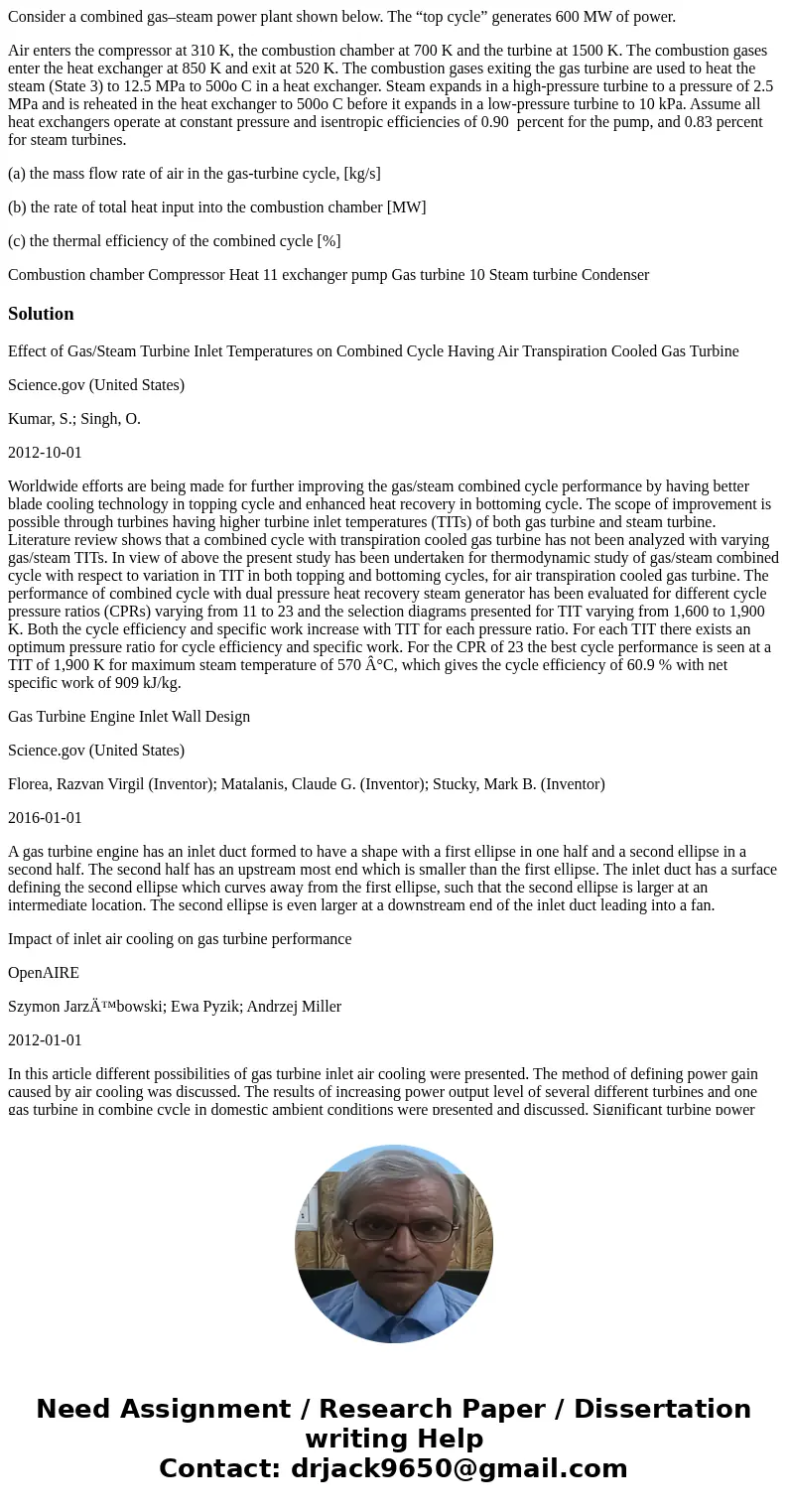
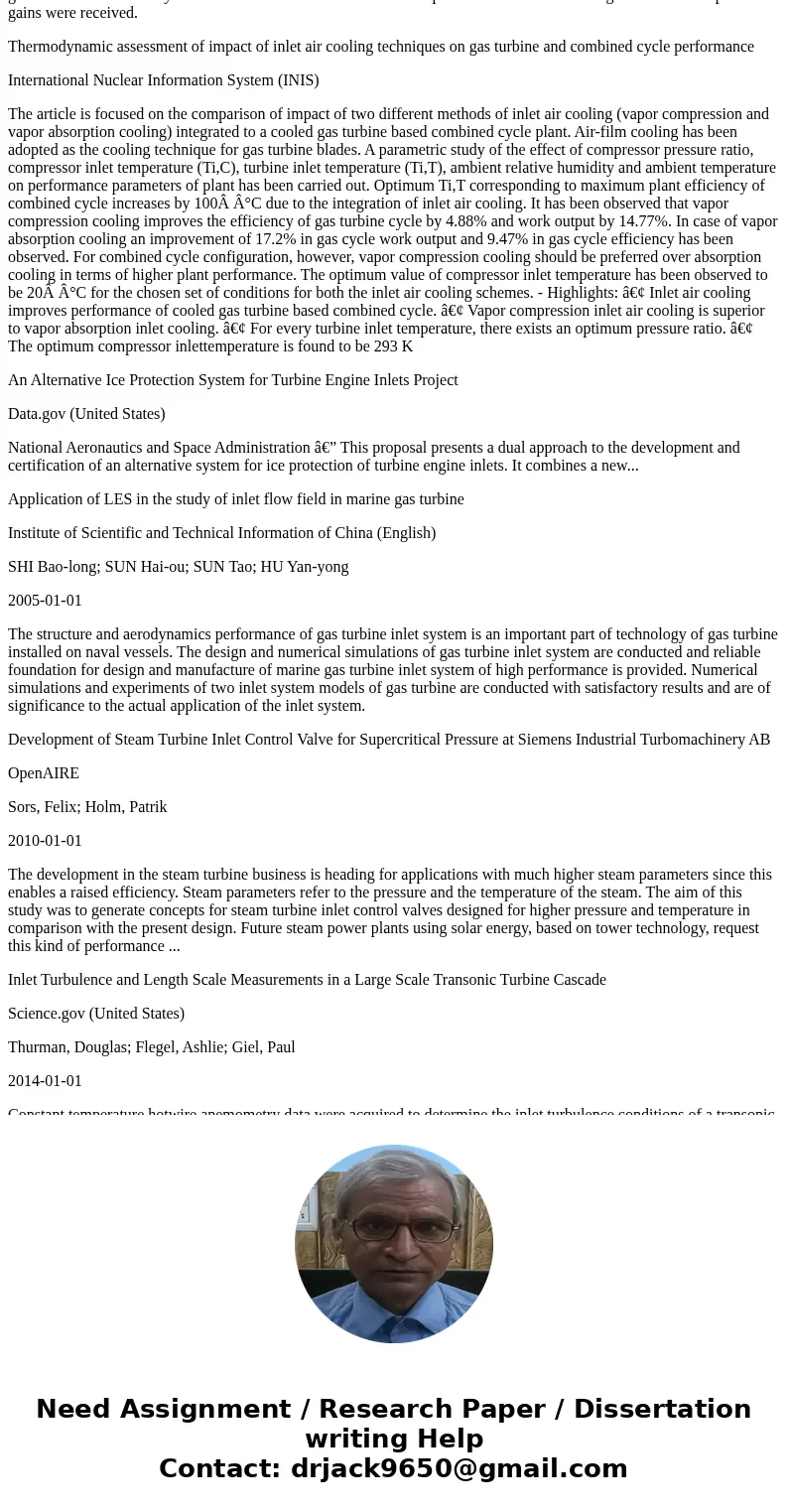
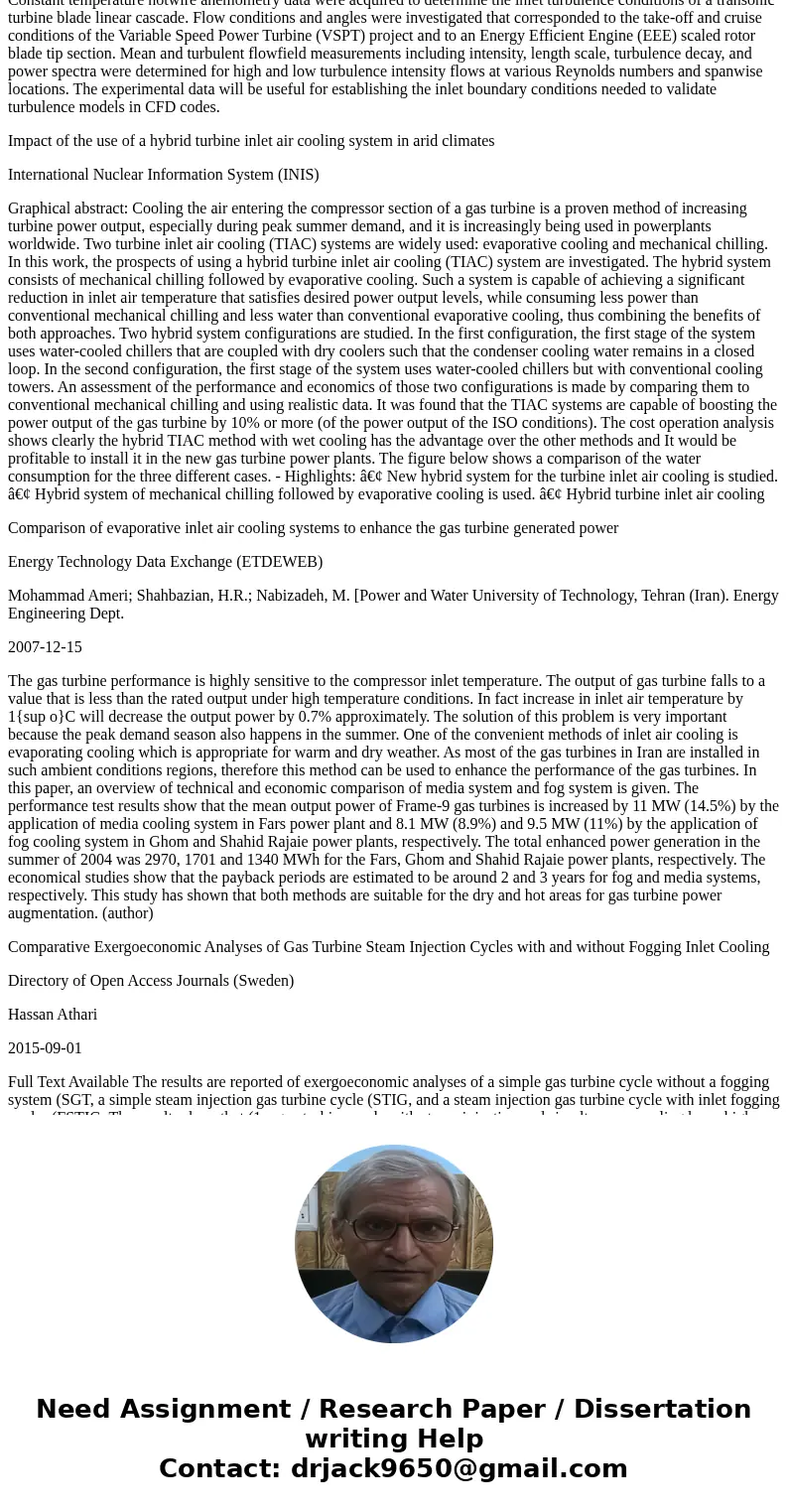
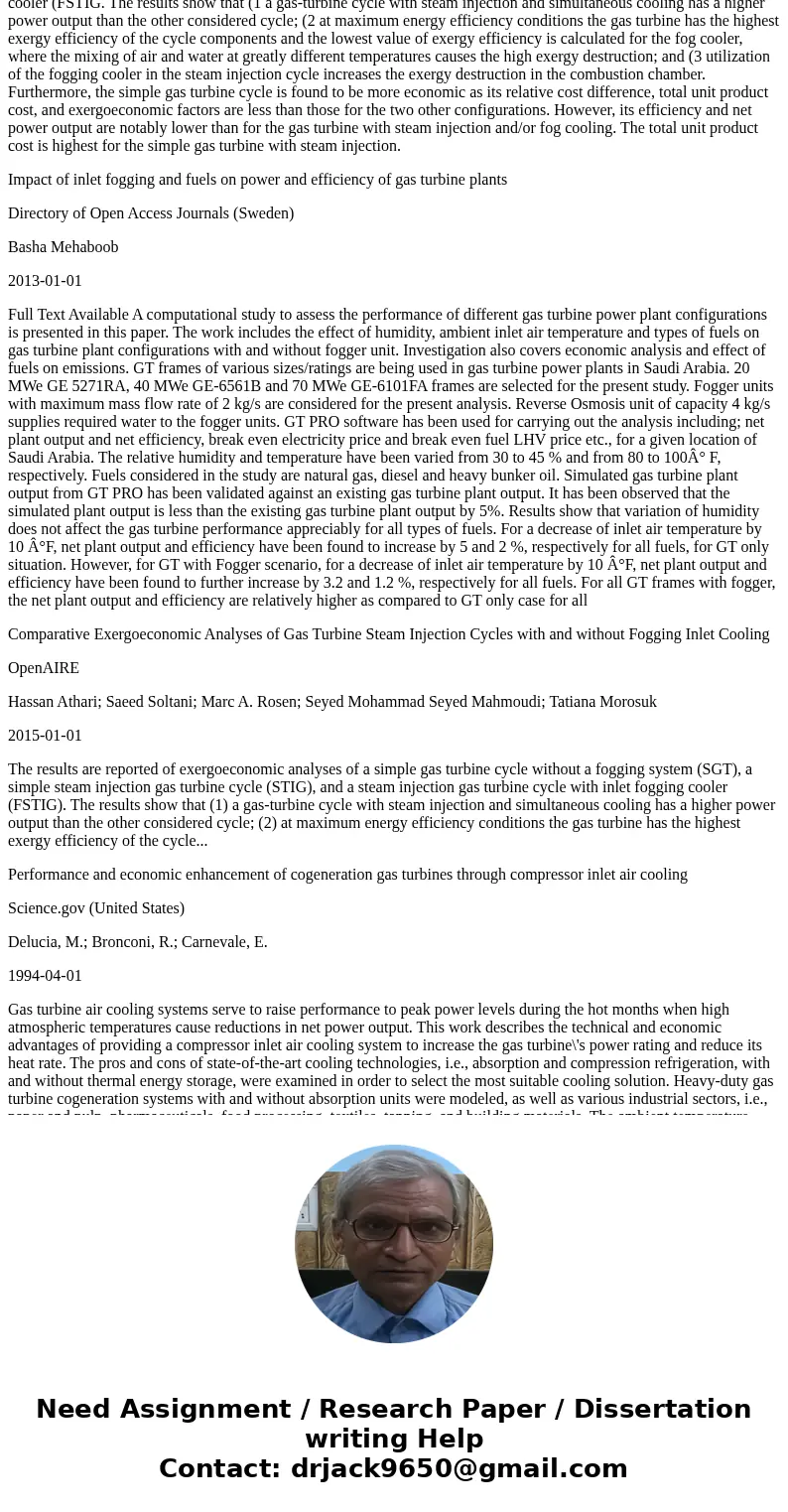
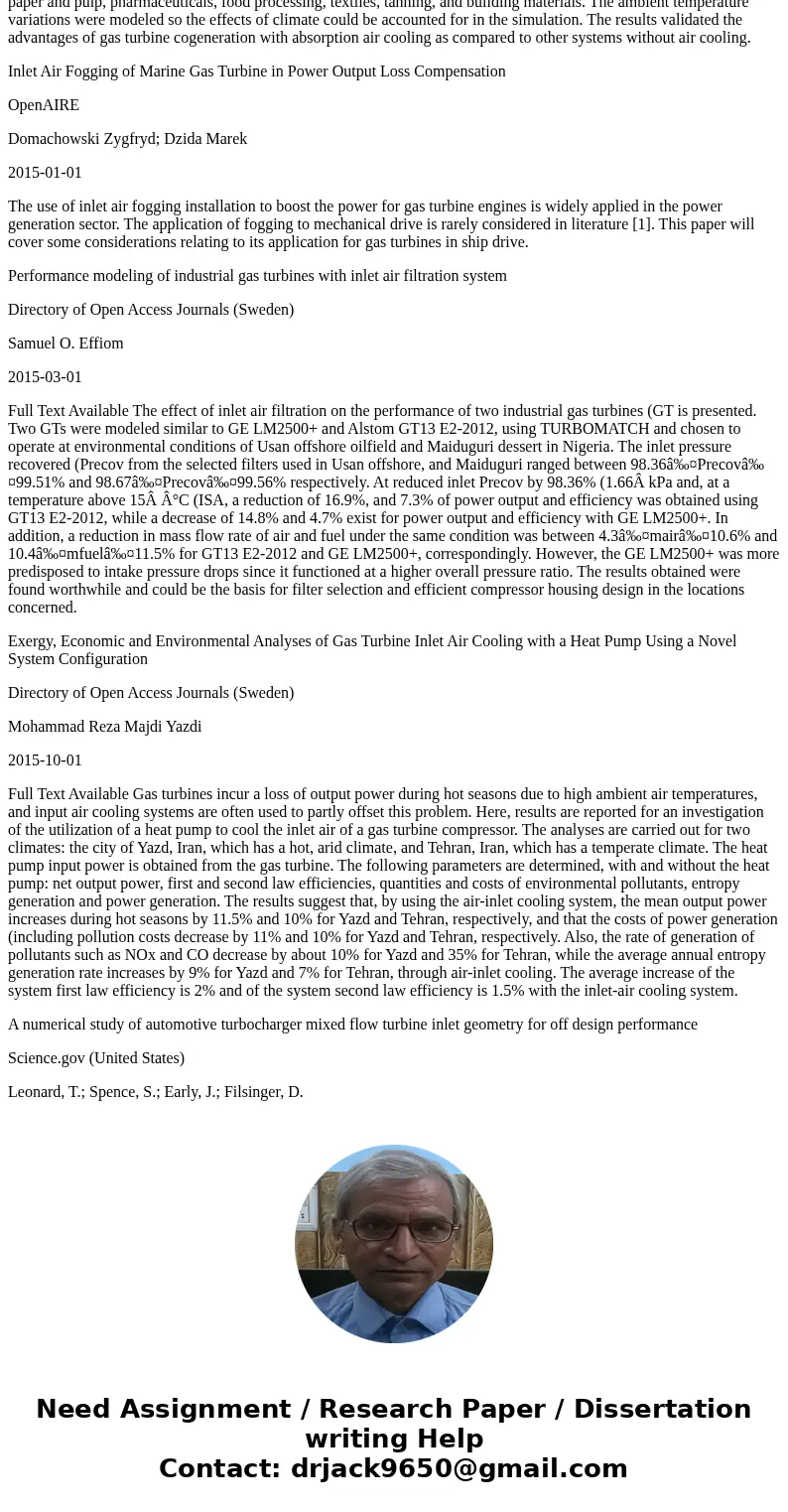
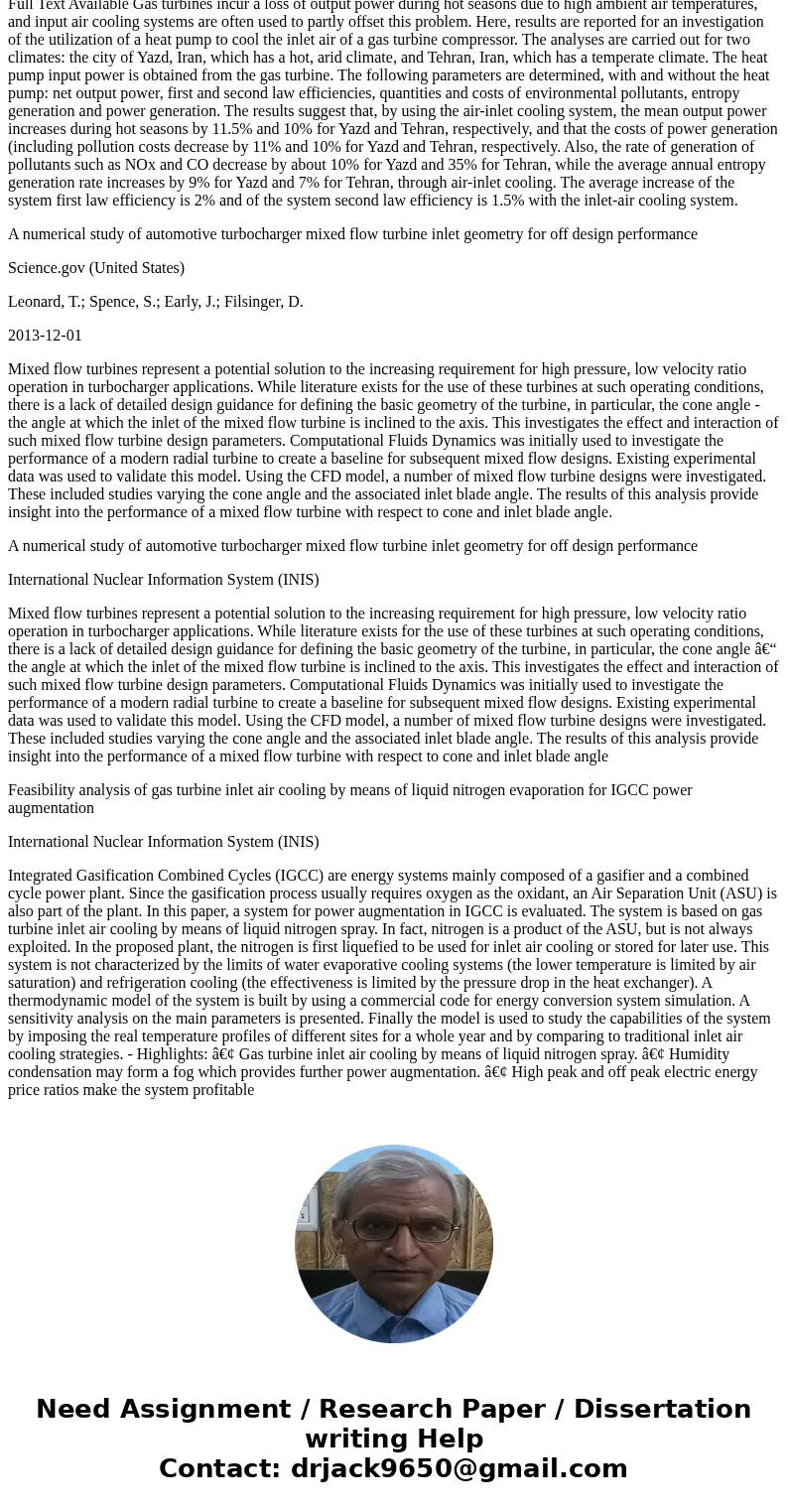
 Homework Sourse
Homework Sourse